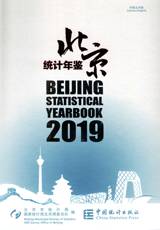《北京统计年鉴》是一部按年连续出版的大型统计资料书,通过大量的统计数据记录北京市一年来经济社会发展变化情况,是国内外各界人士了解北京、认识北京的重要资料工具书。
一、关于框架结构
(一)总体结构
本年鉴整体框架基本保持稳定,彩页部分以图文并茂的形式反映北京市主要经济社会指标发展变化趋势;统计表是年鉴的主体内容,主要包括综合,国民经济核算,人口与就业,价格指数,人民生活,财政与税收,能源、资源和环境,城市公用事业,固定资产投资和房地产开发,对外经济贸易,农业及农村经济,工业,建筑业,第三产业,交通运输邮电业,批发和零售业、住宿和餐饮业,旅游业,金融业,科技,教育,卫生及社会服务,文化和体育,公共管理、社会保障和社会组织,开发区等24个章节,从多领域、多行业反映北京市经济和社会发展情况。
(二)章节结构
章节内结构:每一章节由简要说明、统计表和主要统计指标解释三部分组成。其中,简要说明在每一章节首页,主要介绍该章节的主要内容、统计范围、指标口径和历史数据调整方法,统计指标解释在每章节尾页,主要对本章节内所涉及的主要指标、计算方法等做简要解释。
统计表排列:每一章节从反映该领域主要情况出发编排统计表内容。统计表的排列顺序一般先是主要指标历史数据表,后为当年数据表。
二、关于使用方法
(一)年份
按照惯例,书名中标注的年份为出版年份,年鉴中最新数据为上一年数据。例如,《北京统计年鉴2019》表示该年鉴为2019年出版,年鉴中最新数据年份截至2018年。
统计表名中的“年份”主要有三种标识方法,分别代表三种含义:一是“表格名称(****-****年)”表示表内所列数据是包含了这两个年份之间的各年资料;二是统计表名中未显示年份,表示表内所列数据为当年和上年两年数据;三是“表格名称(****年)”表示表内所列数据仅为某一年资料。
(二)符号
统计表中常见符号如下:
#:表示总计中的其中项;有“#”号的分组指标表示总计的部分项目,无“#”号的分组指标则表示其中项之和等于总计。
‖:宾栏中的“‖”为分组符号,代表某个指标存在几种分组数据。
…:表示该数据不足该表最小计量单位数。
空格:表示该项指标数据不详或没有数据。
***:在可能根据数据识别或者推断单个统计调查对象身份时,予以屏蔽处理,以“***”表示。
(三)数据
1.本年鉴各章节均包含历史数据表和当年数据表两部分。历史数据表中的历史数据一般可以连续使用,部分历史数据有调整的,应以最新出版的年鉴为准,使用时需留意简要说明、表下注释中对方法制度、口径范围等变化情况的说明。当年数据表中如指标的口径范围、计算方法以及与上年度数据相比变化较大时,会在表下注释中进行说明。
2.由于2018年为第四次全国经济普査年份,普査数据尚未发布,因此2018年规模以上法人单位数、地区生产总值、能源、环境保护、房地产、工业、建筑业、文化产业、批发和零售业、开发区等相关数据为年度初步统计数据,还有部分指标暂无2018年数据。2018年年度最终数据可通过2020年出版的《北京统计年鉴2020》进行査询。
3.与2018年版统计年鉴相比,国民经济核算章节增加了1982年以来三次产业和三大需求贡献率历史数据;人民生活章节增加了1978年以来根据城乡住户调査一体化改革调整后的全市和分城乡居民收支历史数据。
(四)电子光盘
《北京统计年鉴》配有电子光盘,包括中文和英文两种语言的版本,辅助用户对数据进行加工处理。
(五)本年鉴中部分数据合计数或相对数由于单位取舍不同而产生的计算误差,均未作机械调整。
Beijing Statistical Yearbook is a large statistical book published continuously on a chronological basis.With a great deal of statistical data,this Yearbook gives a reflection of the economic and social development and changes in Beijing over the past year.It serves as an important reference book for domestic and foreign personnel in all circles to understand and know Beijing.
I.Framework Structure
(I)Overall Structure
The overall structure of Beijing Statistical Yearbook remains basically stable.In color pages,the development and changing trends of main economic and social indicators of Beijing have been presented with both illustration and pictures;statistical tables are the main part of this Yearbook,mainly including 24 chapters,i.e.General Survey;National Accounts;Population and Employment;Price Index;People's Living Conditions;Government Finance and Tax Revenues;Energy,Resources and Environment;Public Utilities;Total Investment in Fixed Assets and Real Estate Development;Foreign Economic Relations and Trade;Agriculture and Rural Economy;Industry;Construction;Tertiary Industry;Transport,Post and Telecommunication Services;Wholesale and Retail Trade,Accommodation and Restaurants;Tourism;Finance;Science and Technology;Education;Health Care and Social Services;Culture and Sports;Public Management,Social Security and Social Organizations;and Development Zones,reflecting the economic and social development situation across the city through multiple fields and industries.
(II)Structure of Chapters
Internal structure of chapters in this Yearbook:Each chapter is composed of the Brief Introduction,Statistical Tables and Explanatory Notes to Main Statistical Indicators.Thereinto,Brief Introduction appears on the first page of eachchapter,mainly introducing the main content,statistical scope,indicator standards,method of adjustment to historical data in each chapter;Explanatory Notes to Statistical Indicators come on the last page of each chapter,mainly giving abrief explanation to the main indicators and calculation method,etc.involved in the chapter.
Arrangement of statistical tables:In each chapter,statistical tables are arranged for the purpose of reflecting the main conditions in the field.Generally speaking,main indicators historical data tables come before current year datatables.
II.How to Use
(I)Years
Conventionally,the year indicated in the title of the book is the year of publication.The latest data indicated in this Yearbook are data in the previous years.For example,this book is titled 2019 Beijing Statistical Yearbook,which means it will be published in 2019 while the latest data in the book is by the end of 2018.
"Years" in the statistical tables are marked in three ways,each indicating a different meaning.Firstly,the statistical table is named“******(AAAA-BBBB)”,which refers to that the data listed in the table are those from the year of AAAA to BBBB;Secondly,the statistical table contains no years,indicating that the data listed in the table are those of current year and last year;Thirdly,the statistical table is named“******(AAAA)”,indicating that the data listed in the table are those of the year of AAAA.
(II)Symbols
Symbols in statistical tables include:
#:means that the item is included in the total.Grouped indicators marked with "#" are part of the total,while those without "#" mean that sum of included items equals to the total.
‖:grouping symbol,means that there are multiple ways of grouping the indicators.
...:means that the figure is less than the minimum measurement unit of the table.
Blank:means tiiat the figure is unknown or unavailable.
***:When it is possible to identify or infer the identity of the individual statistical respondent based on the data,itshall be shielded and indicated with "***".
(Ⅲ)Data1.
1.Each chsapter in this Yearbook consists of two parts:historical data tables and current year data tables.Generally speaking,historical data that are shown in the historical data tables can be used continuously;for some historical data that have been adjusted,please refer to the latest yearbook;When using the data,it is necessary to refer to the Brief Introduction and the explanations on the change in method system,standards and scope in the Notes under the statistical tables.In the current year data tables,if the standards and scope,calculation method for the corresponding indicators,and certain data greatly differ from that of the previous year,they shall be explained in the Notes under the statistical tables.
2.In view of the fact that 2018 is the fourth year of national economic census and the census data have not yet been released,the relevant data on the number of legal entities above designated size,gross domestic product,energy,environmental protection real estate,industry,construction,cultural industry,wholesale and retail trade,and development zones are therefore the preliminaiy statistics of the year,and for some indicators,the data of 2018 are temporarily not available.The final data for 2018 can be queried through the 2020 Beijing Statistical Yearbook published in 2020.
3.Compared with the 2018 Beijing Statistical Yearbook,historical data on the contribution rate of three industries and three demands since 1982 are added in the National Accounts part;historical data on the income and expenditure of residents of the whole city,and of residents in terms of urban and rural areas upon adjustment on the basis of the reform of integration of urban and rural households surveys are added in the People's Living Conditions part.
(Ⅳ)Electronic CD-ROM
Beijing Statistical Yearbook is provided with a CD-ROM,which contains Chinese and English versions of this Yearbook.The CD-ROM helps users in working with and processing the data.
(V)The sum of some statistics or some relative numbers in this Yearbook might have certain calculation errors because of the choice of different units of measurement.All the statistics have not undergone mechanical adjustment.
